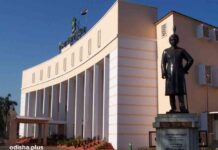Bhaskar Parichha
The book is packed with details of the political tomfoolery.

Journalists writing books on the contemporary political history of India are a few and far between. Here is a critical explanation of India’s political account from the mid-1980s to the second decade of the present century. Parsa Venkateshwar Rao Jr’s ‘Rajiv Gandhi to Narendra Modi: Broken Polity, Flickering Reforms’ is an enviable story of the prime ministers who led governments in these three tumultuous decades.
The years between 1984 and 2014 were eventful in India’s political history for the reason that the country left the past behind and embraced a new future. In these thirty years of reckoning, the two prime ministers who have had maximum influence on the polity are Rajiv Gandhi and Narendra Modi. Of course, they belonged to different genres. Their political milieu was dissimilar. Their social upbringing and political orientation too were different. Yet, in hindsight, they represented the ‘new’ India signifying the ushering in of the crucial reforms and the much-needed novelty in the country’s polity and economy.
As the author says, ‘Gandhi and Modi, the parties and the politics they represent, are an external image of the inner uneasiness and turmoil. The 1984-2018 period is a tale of political turmoil and economic achievement. The old truth that man does not live by bread alone is borne out by the state of the nation in these three decades.’
He further says, ‘in our times, politics is the mirror of the heart of the nation. It is tempting to believe that cracks in the mirror give a distorted image of the heart. It looks like there are cracks in the country’s heart as well. How it can be mended is beyond the scope of this book. What this book intends to do is to hold up the mirror and to show the cracks, call them fault-lines if you will, of the political landscape.’ Shakespearean simile at its best! In the foreword, Lord Meghnad Desai calls the book ‘a brilliant idea of doing a comparative study of Rajiv Gandhi and Narendra Modi.’
Parsa Venkateswar Rao Jr is a senior journalist and has been writing for newspapers across nations for a couple of decades now. Presently the political editor of ‘Parliamentarian’ – a monthly political magazine, his style of writing contemporary political history is exceptional.
From Rajiv Gandhi’s confession about why he came into politics, Narendra Modi’s realistic description of his inner agony during the Gujarat riots, Vajpayee’s charming confession about Nehru, Advani’s confessions in the Lok Sabha about why television was pressed into service during the Kargil War – all this and more has been told in the book in great detail and with a razor-sharp approach. The book, says the blurb, ‘captures the immediacy of history-in-the-making and the palest platitudes of politicians that acquire rare poignancy.’
Divided into twenty chapters, the narrative is acerbic and trenchant. What this book intends to do is to look at oneself and give you an idea about the fault-lines of the political scenario. More fascinating is the fact that the book draws heavily from ‘official’ sources – parliamentary debates, party documents, budget speeches and of course government reports. Apparently, there is a greater authenticity in the narrative. It also brings out, as the author puts it, “the unnoticed details of the unfolding of history.”
Rao argues that ‘majoritarianism cannot hold India’. According to him, the desperation of the present regime is evident in the direction that has been given to its electoral campaign. The author contends that the ‘Modi rhetoric of nationalist glory sounds vainglorious because it lacks inner harmony.’
In the chapter on economic liberalization, he questions the conventional wisdom of viewing P.V. Narasimha Rao as the prime minister who fathered the reforms, with Manmohan Singh at the helm of the process. He differs with the view – which has gained currency in recent years – that Rao has been denied the ‘credit’ that was ‘due’ to him because he was not from the Congress family.
The book is packed with details of the political tomfoolery. It reminds us of the events which have elapsed from our collective memory while providing a toned account of the past. Three chapters in the book make for interesting reading. ‘Romancing Pakistan’, ‘Sonia’s Revenge’ and ’Modi’s Inferno’. Parsa’s description of the sequence of happenings are more often than not forthright and he puts forward his arguments on the basis of parliament debates which he quotes extensively in the book. In scrupulously detailing the turning of events and assertions made by the leaders, Parsa has tried to dress himself as a researcher rather than a critic.
Dismissal of the Naval Chief, Admiral Vishnu Bhagwat being the “ostensible reason” for Jayalalithaa’s withdrawal from the government, Subramanian Swamy’s accusation that George Fernandes as being pro-LTTE, the Ayodhya agony, the Bofors case, the Gujarat riots, and numerous other episodes come into sharp focus in the book.
Having already authored two books on the subject dear to him (Mullah Omar and Robespierre: Essays in the Politics of Ideas and India’s Politics since 1991: Reforms and Revivalism), this book is a definite guide to the myriad political phenomena and will be of much use for those who want to be on familiar terms with India’s opinionated developments in the past thirty years.
Rajiv Gandhi to Narendra Modi
Parsa Venkateswar Rao Jr
SAGE Publications India
BI-1/I, Mohan Cooperative Industrial area
Mathura Road
New Delhi 110044
Rs 450






















